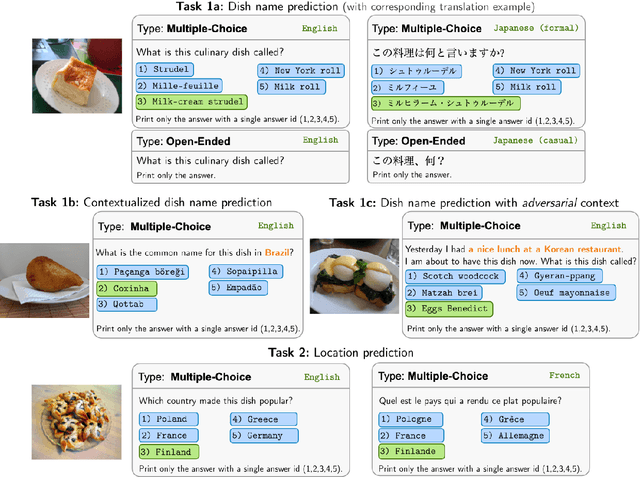Emmanuele Chersoni
Learning to Look at the Other Side: A Semantic Probing Study of Word Embeddings in LLMs with Enabled Bidirectional Attention
Oct 02, 2025Abstract:Autoregressive Large Language Models (LLMs) demonstrate exceptional performance in language understanding and generation. However, their application in text embedding tasks has been relatively slow, along with the analysis of their semantic representation in probing tasks, due to the constraints of the unidirectional attention mechanism. This paper aims to explore whether such constraints can be overcome by enabling bidirectional attention in LLMs. We tested different variants of the Llama architecture through additional training steps, progressively enabling bidirectional attention and unsupervised/supervised contrastive learning.
From BERT to LLMs: Comparing and Understanding Chinese Classifier Prediction in Language Models
Aug 25, 2025Abstract:Classifiers are an important and defining feature of the Chinese language, and their correct prediction is key to numerous educational applications. Yet, whether the most popular Large Language Models (LLMs) possess proper knowledge the Chinese classifiers is an issue that has largely remain unexplored in the Natural Language Processing (NLP) literature. To address such a question, we employ various masking strategies to evaluate the LLMs' intrinsic ability, the contribution of different sentence elements, and the working of the attention mechanisms during prediction. Besides, we explore fine-tuning for LLMs to enhance the classifier performance. Our findings reveal that LLMs perform worse than BERT, even with fine-tuning. The prediction, as expected, greatly benefits from the information about the following noun, which also explains the advantage of models with a bidirectional attention mechanism such as BERT.
Sparse Brains are Also Adaptive Brains: Cognitive-Load-Aware Dynamic Activation for LLMs
Feb 26, 2025Abstract:Dense large language models(LLMs) face critical efficiency bottlenecks as they rigidly activate all parameters regardless of input complexity. While existing sparsity methods(static pruning or dynamic activation) address this partially, they either lack adaptivity to contextual or model structural demands or incur prohibitive computational overhead. Inspired by human brain's dual-process mechanisms - predictive coding (N400) for backbone sparsity and structural reanalysis (P600) for complex context - we propose CLADA, a \textit{\textbf{C}ognitive-\textbf{L}oad-\textbf{A}ware \textbf{D}ynamic \textbf{A}ctivation} framework that synergizes statistical sparsity with semantic adaptability. Our key insight is that LLM activations exhibit two complementary patterns: 1) \textit{Global statistical sparsity} driven by sequence-level prefix information, and 2) \textit{Local semantic adaptability} modulated by cognitive load metrics(e.g., surprisal and entropy). CLADA employs a hierarchical thresholding strategy: a baseline from offline error-controlled optimization ensures 40\%+ sparsity, dynamically adjusted by real-time cognitive signals. Evaluations across six mainstream LLMs and nine benchmarks demonstrate that CLADA achieves \textbf{~20\% average speedup with <2\% accuracy drop}, outperforming Griffin (5\%+ degradation) and TT (negligible speedup). Crucially, we establish the first formal connection between neurolinguistic event-related potential (ERP) components and LLM efficiency mechanisms through multi-level regression analysis ($R^2=0.17$ for sparsity-adaptation synergy). Requiring no retraining or architectural changes, CLADA offers a deployable solution for resource-aware LLM inference while advancing biologically-inspired AI design. Our code is available at \href{https://github.com/Oldify/CLADA}{CLADA}.
ExpliCa: Evaluating Explicit Causal Reasoning in Large Language Models
Feb 21, 2025Abstract:Large Language Models (LLMs) are increasingly used in tasks requiring interpretive and inferential accuracy. In this paper, we introduce ExpliCa, a new dataset for evaluating LLMs in explicit causal reasoning. ExpliCa uniquely integrates both causal and temporal relations presented in different linguistic orders and explicitly expressed by linguistic connectives. The dataset is enriched with crowdsourced human acceptability ratings. We tested LLMs on ExpliCa through prompting and perplexity-based metrics. We assessed seven commercial and open-source LLMs, revealing that even top models struggle to reach 0.80 accuracy. Interestingly, models tend to confound temporal relations with causal ones, and their performance is also strongly influenced by the linguistic order of the events. Finally, perplexity-based scores and prompting performance are differently affected by model size.
Composing or Not Composing? Towards Distributional Construction Grammars
Dec 10, 2024Abstract:The mechanisms of comprehension during language processing remains an open question. Classically, building the meaning of a linguistic utterance is said to be incremental, step-by-step, based on a compositional process. However, many different works have shown for a long time that non-compositional phenomena are also at work. It is therefore necessary to propose a framework bringing together both approaches. We present in this paper an approach based on Construction Grammars and completing this framework in order to account for these different mechanisms. We propose first a formal definition of this framework by completing the feature structure representation proposed in Sign-Based Construction Grammars. In a second step, we present a general representation of the meaning based on the interaction of constructions, frames and events. This framework opens the door to a processing mechanism for building the meaning based on the notion of activation evaluated in terms of similarity and unification. This new approach integrates features from distributional semantics into the constructionist framework, leading to what we call Distributional Construction Grammars.
WorldCuisines: A Massive-Scale Benchmark for Multilingual and Multicultural Visual Question Answering on Global Cuisines
Oct 16, 2024



Abstract:Vision Language Models (VLMs) often struggle with culture-specific knowledge, particularly in languages other than English and in underrepresented cultural contexts. To evaluate their understanding of such knowledge, we introduce WorldCuisines, a massive-scale benchmark for multilingual and multicultural, visually grounded language understanding. This benchmark includes a visual question answering (VQA) dataset with text-image pairs across 30 languages and dialects, spanning 9 language families and featuring over 1 million data points, making it the largest multicultural VQA benchmark to date. It includes tasks for identifying dish names and their origins. We provide evaluation datasets in two sizes (12k and 60k instances) alongside a training dataset (1 million instances). Our findings show that while VLMs perform better with correct location context, they struggle with adversarial contexts and predicting specific regional cuisines and languages. To support future research, we release a knowledge base with annotated food entries and images along with the VQA data.
Comparing Plausibility Estimates in Base and Instruction-Tuned Large Language Models
Mar 21, 2024Abstract:Instruction-tuned LLMs can respond to explicit queries formulated as prompts, which greatly facilitates interaction with human users. However, prompt-based approaches might not always be able to tap into the wealth of implicit knowledge acquired by LLMs during pre-training. This paper presents a comprehensive study of ways to evaluate semantic plausibility in LLMs. We compare base and instruction-tuned LLM performance on an English sentence plausibility task via (a) explicit prompting and (b) implicit estimation via direct readout of the probabilities models assign to strings. Experiment 1 shows that, across model architectures and plausibility datasets, (i) log likelihood ($\textit{LL}$) scores are the most reliable indicator of sentence plausibility, with zero-shot prompting yielding inconsistent and typically poor results; (ii) $\textit{LL}$-based performance is still inferior to human performance; (iii) instruction-tuned models have worse $\textit{LL}$-based performance than base models. In Experiment 2, we show that $\textit{LL}$ scores across models are modulated by context in the expected way, showing high performance on three metrics of context-sensitive plausibility and providing a direct match to explicit human plausibility judgments. Overall, $\textit{LL}$ estimates remain a more reliable measure of plausibility in LLMs than direct prompting.
Extensive Evaluation of Transformer-based Architectures for Adverse Drug Events Extraction
Jun 08, 2023



Abstract:Adverse Event (ADE) extraction is one of the core tasks in digital pharmacovigilance, especially when applied to informal texts. This task has been addressed by the Natural Language Processing community using large pre-trained language models, such as BERT. Despite the great number of Transformer-based architectures used in the literature, it is unclear which of them has better performances and why. Therefore, in this paper we perform an extensive evaluation and analysis of 19 Transformer-based models for ADE extraction on informal texts. We compare the performance of all the considered models on two datasets with increasing levels of informality (forums posts and tweets). We also combine the purely Transformer-based models with two commonly-used additional processing layers (CRF and LSTM), and analyze their effect on the models performance. Furthermore, we use a well-established feature importance technique (SHAP) to correlate the performance of the models with a set of features that describe them: model category (AutoEncoding, AutoRegressive, Text-to-Text), pretraining domain, training from scratch, and model size in number of parameters. At the end of our analyses, we identify a list of take-home messages that can be derived from the experimental data.
Empirical Sufficiency Lower Bounds for Language Modeling with Locally-Bootstrapped Semantic Structures
May 30, 2023



Abstract:In this work we build upon negative results from an attempt at language modeling with predicted semantic structure, in order to establish empirical lower bounds on what could have made the attempt successful. More specifically, we design a concise binary vector representation of semantic structure at the lexical level and evaluate in-depth how good an incremental tagger needs to be in order to achieve better-than-baseline performance with an end-to-end semantic-bootstrapping language model. We envision such a system as consisting of a (pretrained) sequential-neural component and a hierarchical-symbolic component working together to generate text with low surprisal and high linguistic interpretability. We find that (a) dimensionality of the semantic vector representation can be dramatically reduced without losing its main advantages and (b) lower bounds on prediction quality cannot be established via a single score alone, but need to take the distributions of signal and noise into account.
Event knowledge in large language models: the gap between the impossible and the unlikely
Dec 07, 2022



Abstract:People constantly use language to learn about the world. Computational linguists have capitalized on this fact to build large language models (LLMs) that acquire co-occurrence-based knowledge from language corpora. LLMs achieve impressive performance on many tasks, but the robustness of their world knowledge has been questioned. Here, we ask: do LLMs acquire generalized knowledge about real-world events? Using curated sets of minimal sentence pairs (n=1215), we tested whether LLMs are more likely to generate plausible event descriptions compared to their implausible counterparts. We found that LLMs systematically distinguish possible and impossible events (The teacher bought the laptop vs. The laptop bought the teacher) but fall short of human performance when distinguishing likely and unlikely events (The nanny tutored the boy vs. The boy tutored the nanny). In follow-up analyses, we show that (i) LLM scores are driven by both plausibility and surface-level sentence features, (ii) LLMs generalize well across syntactic sentence variants (active vs passive) but less well across semantic sentence variants (synonymous sentences), (iii) some, but not all LLM deviations from ground-truth labels align with crowdsourced human judgments, and (iv) explicit event plausibility information emerges in middle LLM layers and remains high thereafter. Overall, our analyses reveal a gap in LLMs' event knowledge, highlighting their limitations as generalized knowledge bases. We conclude by speculating that the differential performance on impossible vs. unlikely events is not a temporary setback but an inherent property of LLMs, reflecting a fundamental difference between linguistic knowledge and world knowledge in intelligent systems.
 Add to Chrome
Add to Chrome Add to Firefox
Add to Firefox Add to Edge
Add to Edge